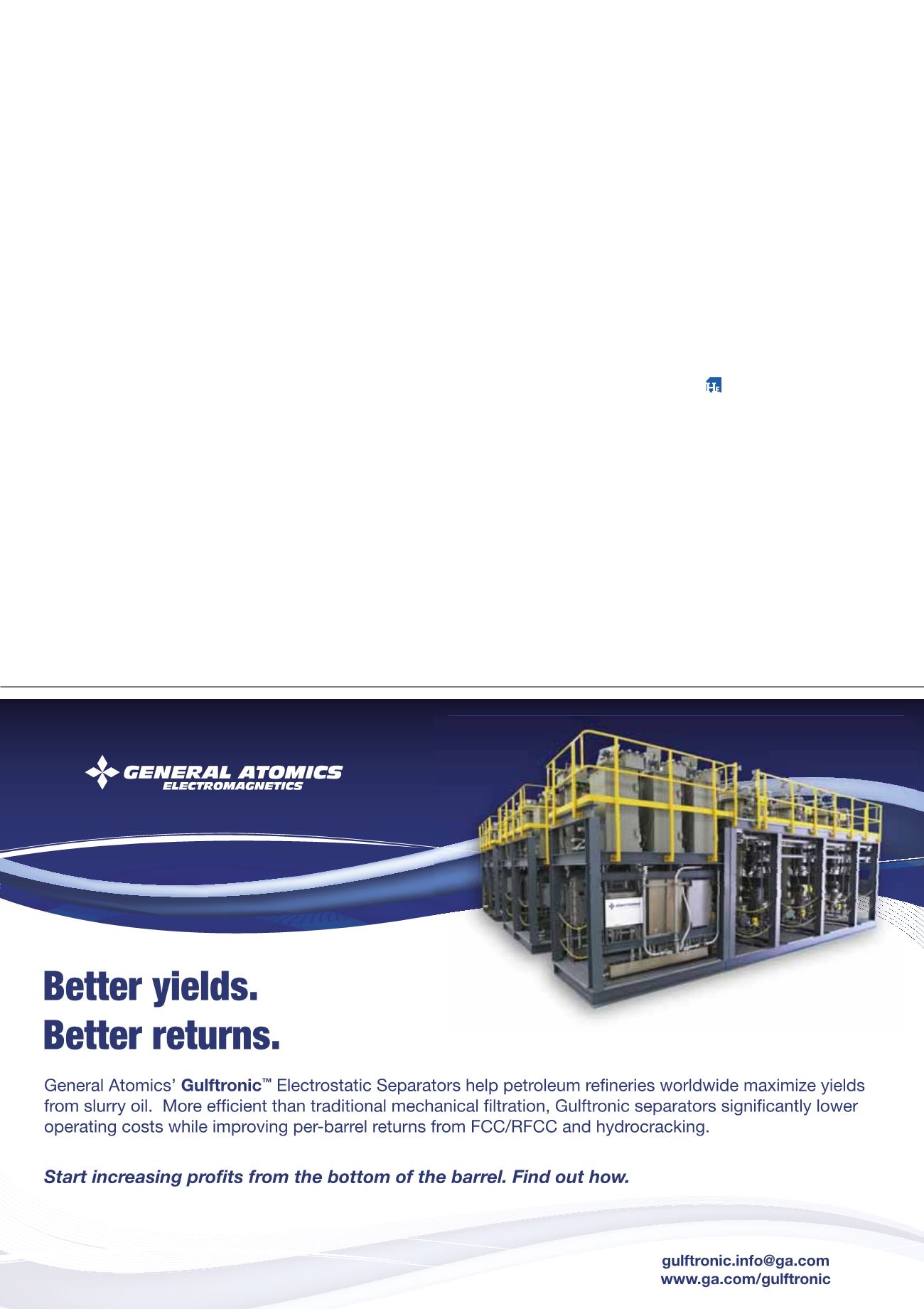
the RFCC of valuable HCO for backflush and increased
overtime due to the constant blockage of the system’s
cartridges. The new electrostatic separator utilises
FCC/RFCC feed as the backflush medium, allowing the
reactor to run at full production with the reduction of
HCO recycle.
The recycling of small fines showed a reduction in
catalyst uptake due to longer reaction time and
increased fluidisation within the reactor. As mentioned
earlier, catalyst savings might vary depending upon
residual units due to multiple factors, but still remain
significant. Individual cases involving deep resid cracking
benefits should be calculated based on a thorough
knowledge of the RFCC feed, operating conditions,
catalyst characteristics, etc. It is important to note that
smaller catalyst particles returned to the unit have an
inherently larger surface to volume ratio and could have
a considerably higher resid cracking activity than the
larger equilibrium catalyst held in the unit. This is an
advantage when separating with electrostatic separation
due to the ability to collect sub-micron particles, too
small for mechanical filtration, during the separation
stage.
Conclusion
The lack of new refinery construction, ongoing
environmental enforcement concerns, and mandated
product quality issues have increased capital addition and
operating costs while reducing flexibility. The challenge for
refineries is to process crude into quality oil products by
removing the impurities as efficiently as possible, while
considering the environment. Each refinery is limited by two
main factors in this area: the products that the refinery is
designed to create and the quality and characteristics of the
crude oil used to create these products. From a filtration
standpoint, slurry oil/FCC fractionator bottoms is one of
the most challenging applications for a refinery. The
electrostatic separator provides an economic and efficient
solution to removing the catalytic fines that would
otherwise devalue residual fuel oil (RFO) and feedstock
products. Every refinery with an FCC/RFCC unit has this
need to highly concentrate solids in the slurry oil into a small
volume for easy recycling, while maximising the recovery of
saleable clarified oil.
By decreasing the operating temperature and not having
to use increased pressures for back washing, the electrostatic
separation process reduces overall operational cost,
maintenance and downtime. These factors provide valuable
returns from the ‘bottom of the barrel.’
References
1. MALLER, A. and DHARIA, D., ‘Alternative Feedstocks, Shale gas Drives
new Opportunities’, Technip Stone & Webster Process Technology,
Houston, Texas, US, (February 2015).
2. MINYARD, W. F. and WOODSON, T. S., ‘Upgrade FCC Slurry Oil with
Chemical Settling Aids’,
World Refining
, (November/December 1999).
3. ELLIOTT, J. D., ‘Impact of Feed Properties and Operating Parameters on
Delayed Coker Petcoke Quality’, presented at the ERTC 2008 Coking
and Gasification Conference.
4. Platts Methodology and Specifications Guide, ‘Petroleum Product &
Gas Liquids: US Caribbean and Latin America’, (January 2012).
5. SILVERMAN, L. D., WINKLER, S., TIETHOF, J. A. and WITOSHKIN, A.,
‘Matrix effects in catalytic cracking’, presented at the 1986 NPRA
Annual Meeting, Los Angeles, California, US, (23 – 25 March 1986).
6.
www.hyd.com/IssueArticle/Optimize-value-from-FCC-bottoms.htm.7. GUERCIO, V. J., ‘US Producing, exporting more slurry oil’,
Oil & Gas Journal
, (4 October 2010).
8. MOTAGHI, M., SHREE, K. and KRISHNAMURTHY, S., ‘Anode Grade Coke
from traditional Crudes’, PTQ, Q2, (2010).








